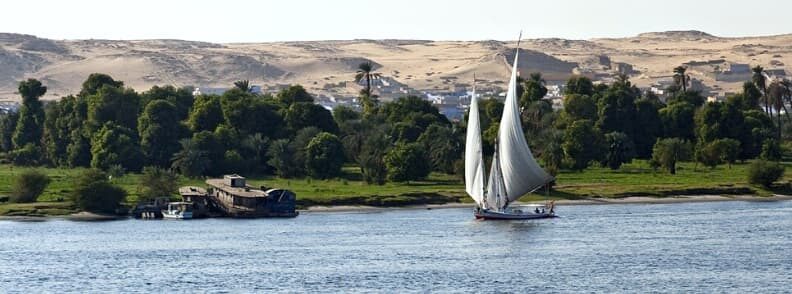Egypt is the birthplace of history and this is where you’ll find the first pictographic record of events and people. Hieroglyphics – the ancient Egyptian writing system – can be traced back to around 3200 BC. Impressive, right?
If this piques your curiosity, join me on a Nile River cruise to discover Egypt’s past on a unique journey. Read on to learn a bit of the land’s history!
Disclosure: Some of the links below are affiliate links. This means that at no extra cost to you, The Travel Bunny will earn a small commission if you click through and make a purchase. Thank you!
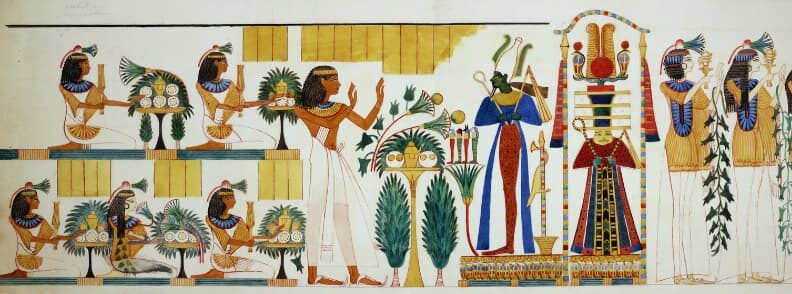
A quick glimpse into Ancient Egypt’s rich history
Ar around 3180 BC, the Upper and Lower Egypt were united under the control of a single ruler, known as Pharaoh. Menes, the first Pharaoh, is considered to have established his capital at Memphis, 22 kilometers south of Giza in what is now modern-day Cairo. The Pharaohs built the mechanisms that led to the development of Egypt’s extremely successful civilization.
Ancient Egypt’s history spanned over 3,000 years. It fell into decline, was conquered, and was afterward governed by foreign countries. Following this collapse, the Greeks and Romans were well aware of the striking similarities between their gods and those of the Egyptians. Not only did they allow Egyptian religion, but they actively enlarged and consecrated new temples to existing cults. In imitation of the Pharaohs, some of the new overlords branded themselves as heavenly priest-kings. One such example you may have heard about is Alexander the Great.
After Christianity became the national religion in Rome, Emperor Theodosius obliterated the final vestiges of the living culture. The Egyptians worshipped hundreds of gods, which was a serious insult to monotheistic religions. In 391 AD, Theodosius ordered the closure of all pagan temples across the Roman Empire. In 640 AD, the Arabs who introduced Islam to Egypt had little time for gods like Anubis the jackal, Horus the falcon deity, or even Amon the ruler of the gods.
Ancient Egypt was thought to be extinct for 1,500 years until the French discovered the Rosetta Stone during Napoleon’s conquest of Egypt in the 18th century. This important find was engraved in both Greek and Egyptian, providing the key that enabled Jean-Francois Champollion to interpret Hieroglyphics in 1822. Curious researchers could now explore the vast literature generated by Ancient Egyptians. This reignited in the West a resurgence of interest in Ancient Egypt that hasn’t waned since.
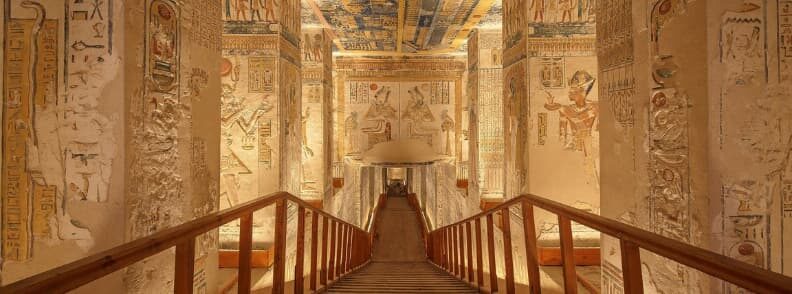
The heritage of the Pharaohs along the Nile
The subject of religion runs through all of ancient Egypt’s attractions. The number of gods deemed worthy of devotion is staggering. There were almost 2,000 of them, both male and female, and they were said to appear to earthlings as animals. The same gods were known by several names in different regions of the nation, creating some overlaps.
There was almost no aspect of life that did not have a deity associated with it: digestion, mummification, sexuality, feasting, childbirth, writing… you name it! Some gods came and departed, but those associated with the most basic parts of life remained. Cults and temples were dedicated to them.
The afterlife was revered, and many of the monuments from back then are dedicated to preparing for that great moment of passing. The preparation of the mortuary and burial sites was meticulous in order to promote a peaceful and joyful life in the other world. Mummification, for example, was thought to be vital because the soul required a corporeal body to inhabit in the afterlife.
However, there was a significant disparity in the preparedness for everlasting life. The Pharaohs, as well as other royals, nobles, and important officials, were mummified and buried with burial goods and valuables. Those who could not afford the entire procedure had to make do with mummy statuettes.
The heritage of the Pharaohs, as well as the Greeks and Romans who ruled after them, is Egypt’s greatest attraction. Essentially, this heritage is linked to temples, graves, and burial grounds. From prehistoric times to the present, Egyptians have always resided beside the Nile River, and it’s here that most ancient structures may be found. You’ll get to see many of them on your Nile River cruise.
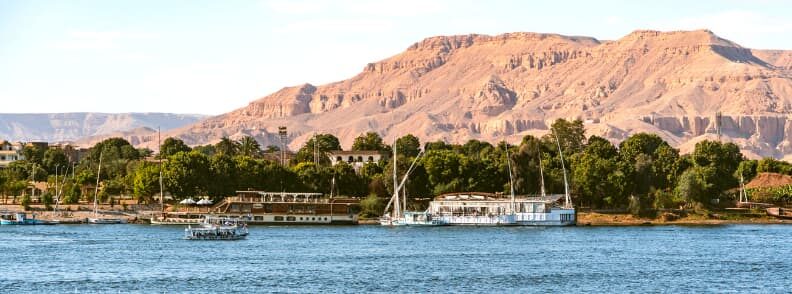
Visiting Egypt on a Nile River Cruise
A Nile River cruise, as many travelers can attest, is the best possible way to discover traditional Egypt. The boat is very nice and it offers a relaxed approach to go close to antiquity’s attractions, which are mostly located around the river’s banks. You also get a peek of rural Egypt: many locals still work just like their forefathers did hundreds of years ago to make a livelihood.
The traditional Nile River cruise ship is more of a floating hotel. Lounges, restaurants, bars, swimming pools, nightclubs, and boutiques will all be available onboard. The rooms are smaller than those found in land-based hotels, but they have air conditioning, TV, and enough space for twin beds, a private bathroom, a nightstand, and a dresser.
Of course, the Nile River cruise ship quality varies, and they are rated with stars in the same way that hotels are. Top-tier cruisers provide spacious accommodation and their facilities are nearly identical to those found on ocean cruisers. But in general, Nile River cruise ships outperform other riverboats everywhere in the globe in terms of quality and romance.
A Nile River cruise itinerary
Nile River cruises are usually three, four, or seven nights long. On the shorter and more popular cruises that run between Luxor and Aswan, you’ll be able to visit the most important and noteworthy sites. Dendera is reached through the longer sail. The boats go both downstream and upstream, and you may board in Aswan or Luxor for shorter journeys.
Luxury Nile River cruises are avoided by more daring visitors or those on a low budget in favor of classic Nile sailboats called feluccas. Though the amenities onboard feluccas are poor, those who can endure them may tour all of the Nile’s sights for a tenth of the price of a Nile River Cruise
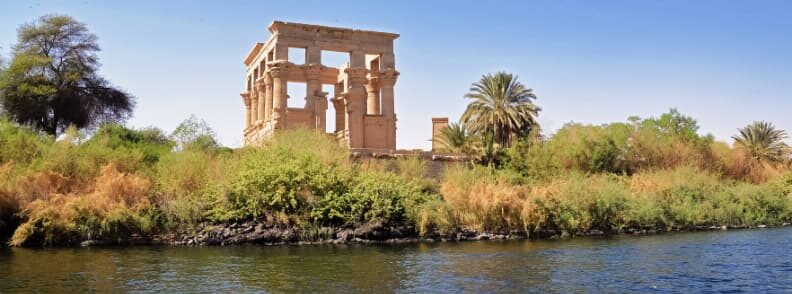
Aswan
The Nile in Aswan is deep, peaceful, and at its most beautiful. It’s a great spot to start your Nile River cruise.
For a long time, Aswan served as Egypt’s southern border city and entrance to Africa. This was Upper Egypt, located upstream of the Nile. The Nile travels through an area of hard rocks beyond Aswan, causing rapids or cataracts.
Aswan gained its strategic location as a result of nature, and it has acted as a garrison town for those who have controlled Egypt over the years. As a result, there are monuments dedicated to the Pharaohs, Greeks, Romans, Christian Copts, and Muslims here.
Visit the Philae Temple in Aswan. When the Greeks were in power, Ptolemy II began the construction of the temple, which was finished by the Romans. It was dedicated to the goddess Isis, who was revered across the Roman Empire as a prominent character in Egyptian mythology.
Even after Emperor Theodosius ordered all pagan temples to go down, Isis was still being worshipped in Philae until Emperor Justinian closed it down around 550 AD. The hypostyle hall of the temple was turned into a chapel by the early Christians. They also vandalized several of the pagan reliefs that adorned its walls for good measure.
The nightly sound-and-light spectacle is set against the backdrop of the Aswan Philae Temple. After the Aswan High Dam was built in the 1960s, this temple was almost completely destroyed. It took UNESCO and the Egyptian government ten years to transfer it to higher ground on Agilka Island, one stone at a time.
Elephantine Island, with several temples and a museum, is also popular with travelers. Since around 3,000 BC, the island has been populated and served as important commerce and cultural center.
The granite stone used by the Pharaohs to construct temples and other structures came from Aswan. The massive Unfinished Obelisk may be seen in the Northern Quarries. If the obelisk were to be built, it would be the world’s biggest monolithic masonry, standing 42 meters tall and weighing over 1,168 tons. It must have shattered the builders’ hearts since they allegedly abandoned it after discovering flaws in the rock formation.
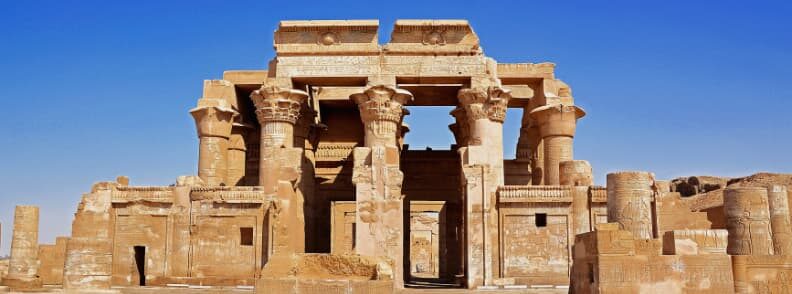
Kom Ombo
The next destination of your Nile River cruise is Kom Ombo, 48 kilometers north of Aswan.
The Greek-Roman Kom Ombo temple is the primary attraction here. Ptolemy VII began the construction of this temple in the early 2nd century BC, and his successors finished it. Around 30 BC, the Roman Emperor Augustus raised a portion of the temple.
The Temple of Kom Ombo is made of two separate buildings, actually. Each of them has its own entrance, colonnades, hypostyle hall, and sanctuary. The crocodile deity Sobek is honored in the southern temple, while Horus, the falcon god, is honored in the northern one.
In Egyptian mythology, Sobek was connected with the deity Seth, an adversary of Horus. But that didn’t stop the two gods from sharing the same grounds. They even took advantage of the place and brought their families to Kom Ombo: Sobek brought his consort Hathor and his son Khonsu, while Horus brought his wife Tesentnefert and his son Panebtawy.
If you’ve never seen mummies before, the mummified crocodiles in the Sobek section of the temple are a must-see.
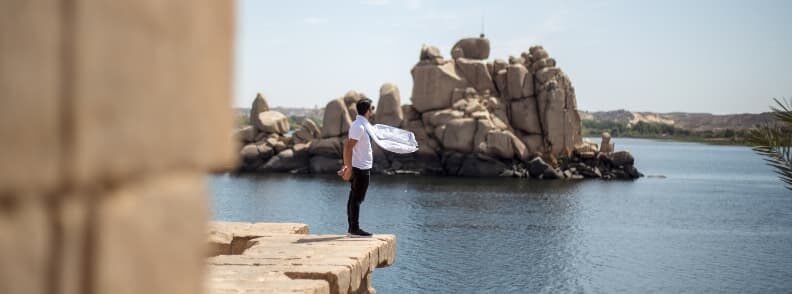
Edfu
You will disembark from your Nile River cruise in Edfu to visit the Temple of Horus, possibly the best surviving of Egypt’s ancient temples.
Horus, the falcon deity, had his cult center in Edfu. Ptolemy III began building the current temple on the site of an ancient Pharaonic construction in 237 BC. Work continued under the Ptolemies who came after. The entryway is appropriately ornamented by two beautiful granite falcons. Horus is depicted in relief on the walls. One scene, in particular, would satisfy any tyrant: it depicts Ptolemy XII ruthlessly dispatching his foes.
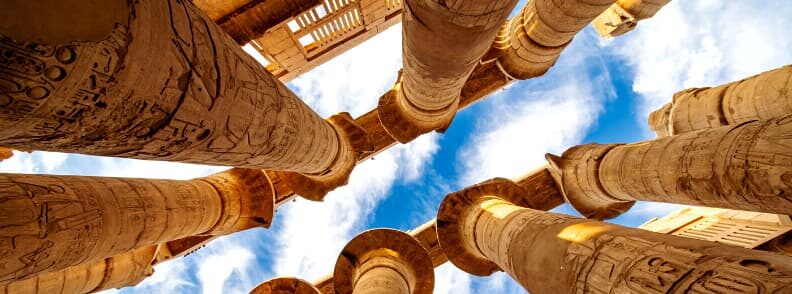
Luxor
Luxor is the next stop and highlight of your Nile River cruise. The diversity, variety, and beauty of the monuments in the Luxor region are unparalleled in Egypt. Known to the Greeks as Thebes, the city became Egypt’s capital in 2040 BC. It survived an Assyrian raid in the 7th century BC, but it gradually deteriorated until it was destroyed by the Romans in the 1st century BC.
The necropolis complexes in the Valley of the Kings, Valley of the Queens, and Tombs of the Nobles are among Luxor’s most famous monuments. You’ll also come across several magnificent temples strewn over the area.
The Egyptians buried their deceased in the direction of the setting sun, while kings and senior officials were buried on the west bank of Luxor. The monarchs of the New Kingdom era (1550-1070 BC), as historians refer to it, awaited the afterlife in the Valley of Kings. The Pharaoh usually chose the location for his tomb and had it erected during his reign. Tomb construction for royalty and prominent officials was a serious business, and it maintained a small community of architects and artisans in the valley.
The tombs have deteriorated in recent years as a result of growing tourist numbers, pollution, and rising groundwater levels caused by the Aswan High Dam. As a result, they aren’t all open to the public. And unless you’re a scholar, three or four tomb visits should be enough. The tombs of Ramses I, Tuthmosis III, and Ramses VI are among the best to visit in Luxor. Tutankhamun’s tomb is the most renowned today, despite the fact that he was not a notable Pharaoh and died at the age of nineteen.
There are 63 tombs that have been unearthed thus far in the Valley of the Kings. But five ancient tombs still remain a mystery. Those would be of Thutmosis II, Nefertiti, Ankhesenamun, Ramses VIII, and Alexander the Great.
Most of the Valley’s graves have been robbed by treasure hunters throughout the years. However, in 1922, British archeologist Howard Carter uncovered Tutankhamun’s tomb practically intact. The riches discovered here are incredible, and include sculptures, trunks, chariots, beds, swords, and a lot more stuff he would need in the hereafter. Tutankhamun’s mummy used to be the most important object in his tomb, but it got moved to Cairo’s Grand Egyptian Museum in 2021, together with around 1700 objects he was buried with. The 11-kilogram pure gold death mask is the most impressive piece in the collection. (Just think what grave robbers took from the larger tombs of more prominent Pharaohs!)
The Temple of Deir el-Bahri, erected by Queen Hatshepsut, is located on the other side of the Valley of Kings. From afar, the temple is rather stunning and makes for an excellent photo opportunity.
The name Valley of the Queens is deceptive, as it contains the graves of both male and female royals, as well as some high-ranking bureaucrats. Around 80 tombs have been discovered here, the most renowned of which is that of Queen Nefertari.
More beautiful photos can be taken at the Colossi of Memnon, which are two massive sculptures that are the last remnants of Amenhotep III’s temple.
On the east bank, Amenhotep III constructed the Luxor Temple, devoted to the deity Amon. Sphinxes line the temple’s entryway, while colonnades, courts, obelisks, and wall paintings may be found inside. There is also a shrine to Alexander the Great within. Shaykh Yusuf Abu al-Hajjaj’s Mosque was erected on top of a portion of this temple. You should also go to the Luxor Museum, which has some intriguing local exhibits.
The massive Temple of Karnak, dedicated to the deity Amon, is a magnificent structure. This was Egypt’s most prominent temple during the New Kingdom period. It’s the world’s largest religious structure, capable of holding the equivalent of ten typical Christian churches. The massive hypostyle hall, Tarhaka’s Kiosk, Ramses II’s monument, Ramses III’s temple, and the holy lake are only a few of the complex’s remarkable buildings.
I recommend hiring a guide to take you around the monuments and explain the historical context of each one. The services of a guide are normally included in the price of a Nile River Cruise package.
What is the best time of year to do a Nile cruise?
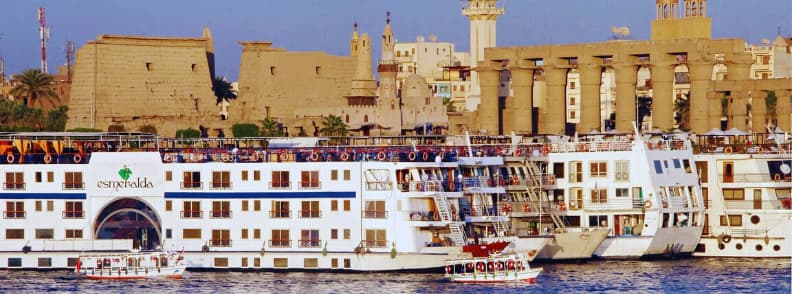
The best time to go on a Nile River cruise is between November and March when the weather is cooler. These are also the busiest months, so get up early every day to escape the crowds.
The end of the hot season in October is also pleasant, especially when you consider that it’s considered off-season: everything is cheaper and less crowded!
How safe are Nile River cruises?
Nile River cruises are very safe. The Egyptian authorities offer complete protection and the security at all points of interest along any Nile cruise is extremely stringent.
What do you wear on a Nile river cruise?
You’ll be doing a lot of walking, so wear comfortable shoes. Light clothes are normally appropriate, while cold evenings may necessitate a sweater and jacket.
Sunglasses and sun protection lotion are also recommended goods to bring. Remember also to always leave your Nile River cruise ship with bottled water and a camera!

Mirela Letailleur is a Romanian travel blogger living in the South of France. She writes on The Travel Bunny travel blog about affordable travel in Europe, creator of unique free travel guides, local travel expert. Problem solver. Wannabe coffee guru.
Other articles you should read on The Travel Bunny travel blog
A guide to booking cheap cruise holidays
4 steps to the perfect spring break cruise
5 best romantic vacation ideas for couples

